|
Hawaii
Author: Gregory Daigle
Publisher: Hans im Glück
Year: 2011
review by

| x |
|
|
|
|
|
|
|
|
|
|
|
|
|
|
|
|
|
|
|
|
|
|
|
|
|
|
|
|
|
|
|
|
|
|
|
|
|
|
|
|
|
|
|
|
|
|
|
|
|
|
|
|
|
|
|
|
|
|
|
|
|
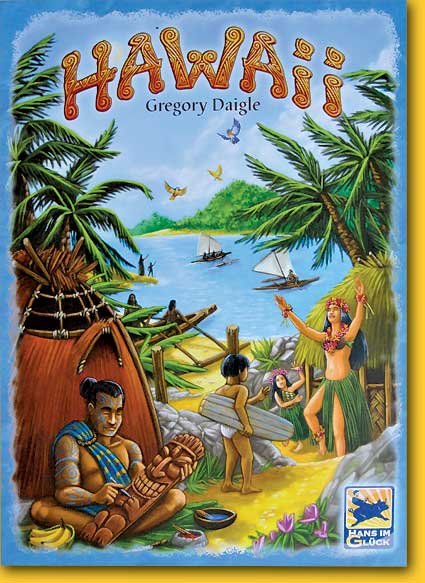 |
When we think about Hawaii, we imagine long white beaches, tanned surfer dudes, swaying palm trees, while we sipping our cocktail, a typical flower garland around our neck. The Hawaii board game confirms most of these clichés, although the players will need to work really hard before they are allowed to rest. The fact is that the players travel as village chiefs across the island, with sometimes a possible excursion to nearby islands or fishing grounds, meanwhile gathering things for establishing and enhancing their villages.
|
|
|
| x |
|
|
|
|
|
|
|
|
|
|
|
|
|
|
|
|
|
|
|
|
|
|
|
|
|
|
|
|
|
|
|
|
|
|
|
|
|
|
|
|
|
|
|
|
|
|
|
|
|
|
|
|
|
|
|
|
|
|
|
|
|
| To set up the game is quite a job by itself. The modular central game board consists of a border, in the shape of the island, which shows both the scoring track as well as the beach. This border has room for ten rectangular tiles, that are randomly placed within the border. On these tiles the 126 (!) smaller tiles are placed, indicated by the spaces on the Hawaii tiles. |
|
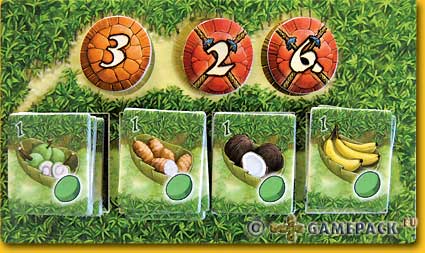 |
|
|
| x |
|
|
|
|
|
|
|
|
|
|
|
|
|
|
|
|
|
|
|
|
|
|
|
|
|
|
|
|
|
|
|
|
|
|
|
|
|
|
|
|
|
|
|
|
|
|
|
|
|
|
|
|
|
|
|
|
|
|
|
|
|
 |
|
These small tiles will need to be bought by the players to raise and enhance their villages. Hut tiles, fruit tiles, boat tiles, there is a large collection to choose from. Four of the smaller island tiles are turned over and laid out opposite to the beach. |
|
|
| x |
|
|
|
|
|
|
|
|
|
|
|
|
|
|
|
|
|
|
|
|
|
|
|
|
|
|
|
|
|
|
|
|
|
|
|
|
|
|
|
|
|
|
|
|
|
|
|
|
|
|
|
|
|
|
|
|
|
|
|
|
|
| For each of the five rounds there is a tile to keep track of the rounds, showing administrative data to be used at the ends of each round. Each of the 2 to 5 players receives a corner-shaped player’s board on which a maximum of five villages can be raised. Each player also gets three pawns in the player’s colours; one is placed on the scoring tracks, one on the order track, and the big one is placed on the beach, ready for travelling. |
|
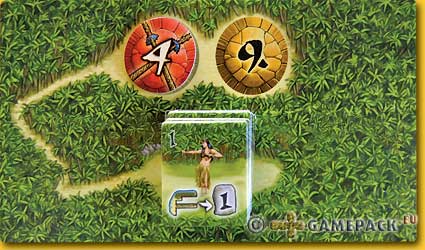 |
|
|
| x |
|
|
|
|
|
|
|
|
|
|
|
|
|
|
|
|
|
|
|
|
|
|
|
|
|
|
|
|
|
|
|
|
|
|
|
|
|
|
|
|
|
|
|
|
|
|
|
|
|
|
|
|
|
|
|
|
|
|
|
|
|
|
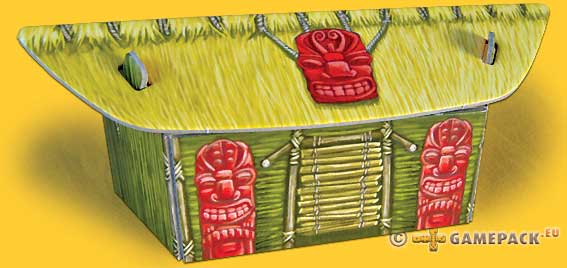
|
For travelling by boat the players are equipped with a small fishing boat, with a capacity of two spaces. Finally, the players receive their starting income. On Hawaii there are three currencies: shells for buying, feet for travelling, and fruit for both. All 'money' is placed behind the player’s screen, which has the shape of a Hawaiian hut. |
|
|
| x |
|
|
|
|
|
|
|
|
|
|
|
|
|
|
|
|
|
|
|
|
|
|
|
|
|
|
|
|
|
|
|
|
|
|
|
|
|
|
|
|
|
|
|
|
|
|
|
|
|
|
|
|
|
|
|
|
|
|
|
|
|
|
Hawaii is player in five identical rounds. Players earn points during and at the end of a round, and also at the end of the game, when all sorts of bonus points can be scored. At the start of each round the prices for all items on the main island are established. Each Hawaii tile has 1 to 3 spaces where small, round price tiles can be placed. These are drawn blindly from a bag and have a value from 2 to 6.
|
|
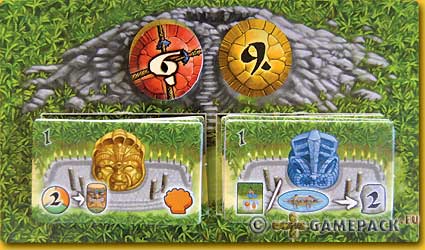 |
|
|
| x |
|
|
|
|
|
|
|
|
|
|
|
|
|
|
|
|
|
|
|
|
|
|
|
|
|
|
|
|
|
|
|
|
|
|
|
|
|
|
|
|
|
|
|
|
|
|
|
|
|
|
|
|
|
|
|
|
|
|
|
|
|
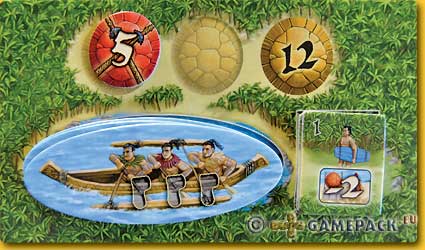 |
|
When the sum of the price tile is higher than the number indicated on the Hawaii tile, the price tile is not placed, but flipped over, showing a number of fish, and then put in the fishing area where it can be caught during a round. It may happen that a Hawaii tile does not get any price-tiles, making it useless for the round; nothing can be bought there. On the player order track some remaining price tiles are placed; one less than the number of players, in increasing order.
|
|
|
| x |
|
|
|
|
|
|
|
|
|
|
|
|
|
|
|
|
|
|
|
|
|
|
|
|
|
|
|
|
|
|
|
|
|
|
|
|
|
|
|
|
|
|
|
|
|
|
|
|
|
|
|
|
|
|
|
|
|
|
|
|
|
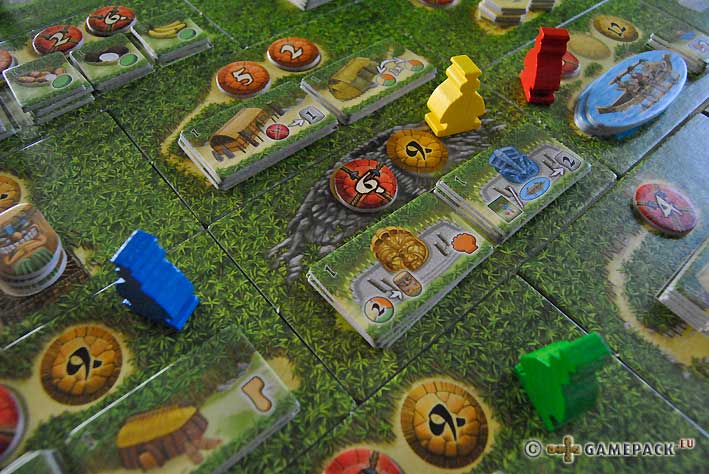 |
|
|
| xx |
|
|
|
|
|
|
|
|
|
|
|
|
|
|
|
|
|
|
|
|
|
|
|
|
|
|
|
|
|
|
|
|
|
|
|
|
|
|
|
|
|
|
|
|
|
|
|
|
|
|
|
|
|
|
|
|
|
|
|
|
|
|
A player’s turn basically is very simple: move the chief to a new spot on the (main) island, and perform the available action there. Movement can be done in two ways: across the island, or to the beach. For movement across the island one foot per tile has to be paid. On arrival on the selected one of the available tiles must be bought, by paying the amount of shells indicated on one of the price tiles. The player takes both the tile just bought and the price tile. The tile bought is placed in one of the villages on the player’s board, according to some placement rules. The price tile is placed in front of the player.
|
|
|
| x |
|
|
|
|
|
|
|
|
|
|
|
|
|
|
|
|
|
|
|
|
|
|
|
|
|
|
|
|
|
|
|
|
|
|
|
|
|
|
|
|
|
|
|
|
|
|
|
|
|
|
|
|
|
|
|
|
|
|
|
|
|
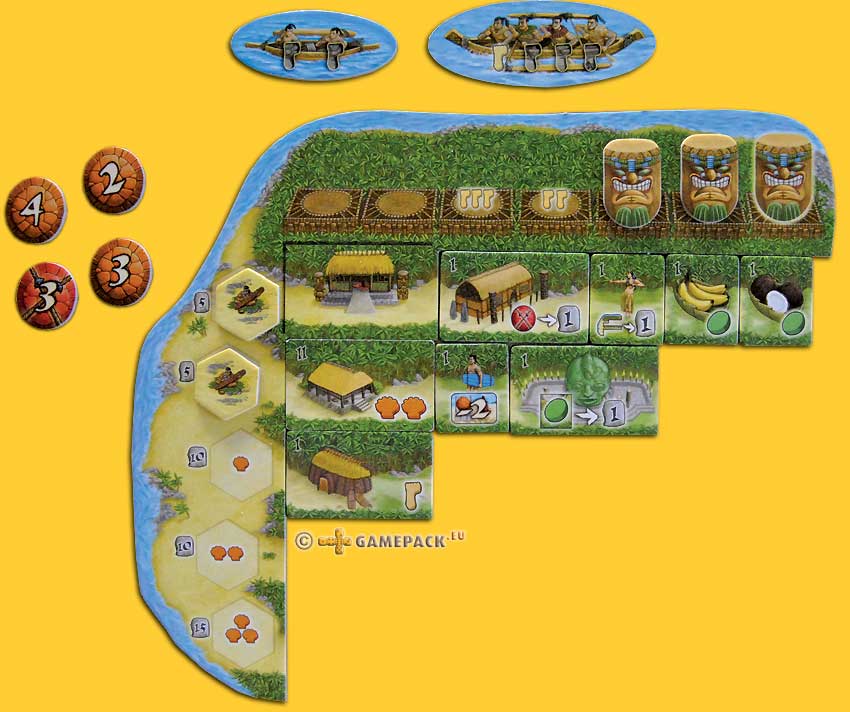 |
|
|
| x |
|
|
|
|
|
|
|
|
|
|
|
|
|
|
|
|
|
|
|
|
|
|
|
|
|
|
|
|
|
|
|
|
|
|
|
|
|
|
|
|
|
|
|
|
|
|
|
|
|
|
|
|
|
|
|
|
|
|
|
|
|
|
A number of tiles are two-sided; if a player wants to pay the double amount of shells, he can place the tile in his village showing the more advantageous reverse side. As an example take the shell-hut tile: when normally placed this gives one additional shell at the end of each round. When reversed, the player gets two shells. If an Hawaii-tile does not offer this advantage, the player can buy two tiles for the double price. Examples are the tiki tiles, which are placed at the top of the player’s board, and which are necessary to enable the end-game scoring of villages.
The second possible movement is (back) to the beach. Three actions are available here to the player: fishing, sailing, or passing. For fishing the player can take a fish tile (the reverse side of a price tile) by paying one foot.
|
|
 |
|
|
| x |
|
|
|
|
|
|
|
|
|
|
|
|
|
|
|
|
|
|
|
|
|
|
|
|
|
|
|
|
|
|
|
|
|
|
|
|
|
|
|
|
|
|
|
|
|
|
|
|
|
|
|
|
|
|
|
|
|
|
|
|
|
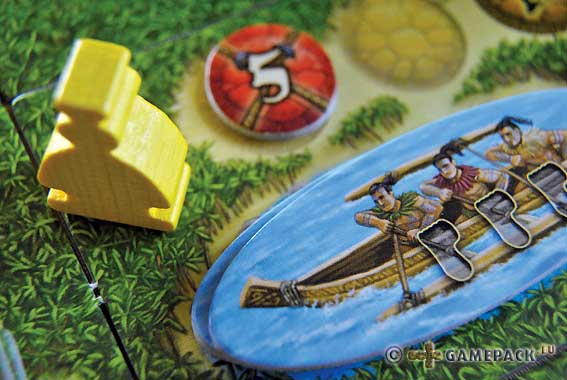 |
|
When fishing some boat capacity is required as well. Initially the capacity is just two, for two fish tiles, but this capacity can be enlarged by buying bigger and more boats. The fish-tiles are used for the end of round scoring. For sailing a boat with a capacity of at least three spaces is required. For this action an amount of feet has to be paid as well. The small islands offer basically the same items as the tiles on the main island, but they do not require payment by shells, and give also some immediate points. As a final option on the beach, a player can pass; he places his pawn on one of the available free spaces of the order track, and takes any price tile, if available. |
|
| x |
|
|
|
|
|
|
|
|
|
|
|
|
|
|
|
|
|
|
|
|
|
|
|
|
|
|
|
|
|
|
|
|
|
|
|
|
|
|
|
|
|
|
|
|
|
|
|
|
|
|
|
|
|
|
|
|
|
|
|
|
|
When all players have passed, it is time for the end-of-round scoring. For this purpose all players add the values on their obtained price- and fish-tiles, and compare the result with the threshold for this round, which will increase each round. When a player’s result equals or exceeds the threshold, he scores points, depending on the round, and the results of the other players.
For the next round the playing order has already been established. The players gets new income depending on the round, and increased (hopefully) by the shells, feet, and fruit shown on the tiles in their villages. All price- and fish tiles are gathered and put in the bag again and a new round can start. |
|
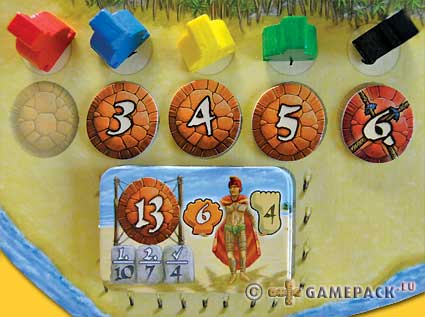 |
|
|
| x |
|
|
|
|
|
|
|
|
|
|
|
|
|
|
|
|
|
|
|
|
|
|
|
|
|
|
|
|
|
|
|
|
|
|
|
|
|
|
|
|
|
|
|
|
|
|
|
|
|
|
|
|
|
|
|
|
|
|
|
|
|
| After five rounds the game is finishes and the end of game scoring can be performed. Certain bonus tiles can give considerable bonus points, if the villages where they are located are being protected by tiki tiles. The Kahuna tiles can be attractive as well, possibly giving a maximum of 45 points, when all five villages are built, protected and have been allocated a Kahuna tile. When all points scored the player with the most points is winner, and he finally can start sipping his well-deserved cocktail. |
|
|
| x |
|
|
|
|
|
|
|
|
|
|
|
|
|
|
|
|
|
|
|
|
|
|
|
|
|
|
|
|
|
|
|
|
|
|
|
|
|
|
|
|
|
|
|
|
|
|
|
|
|
|
|
|
|
|
|
|
|
|
|
|
|
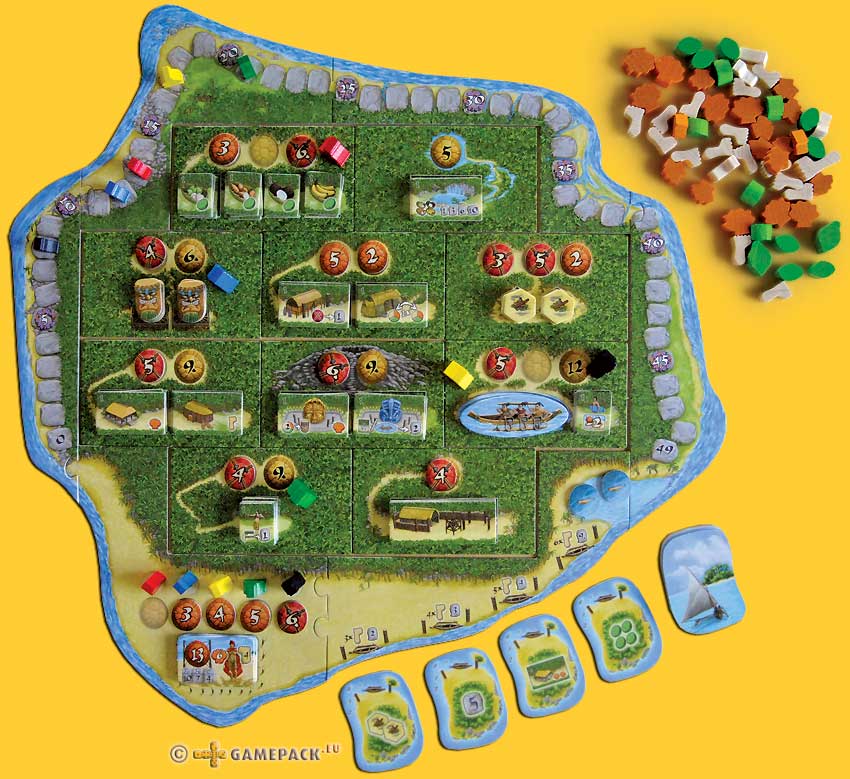 |
| x |
|
|
| x |
|
|
| x |
|
|
 |
|
|
|
|
|
|
|
|
|
|
|
|
|
|
|
|
|
|
|
|
|
|
|
|
|
|
|
|
|
|
|
|
|
|
|
|
|
|
|
|
|
|
|
|
|
|
|
|
|
|
|
|
|
Tiles, a lot of tiles, that is the first impression when setting up the game to play. This can be a bit overwhelming at first for the less experienced player. However, with a bit of experience or persistence it soon becomes clear that 'Hawaii', with respect to the rules, is not a very complex game. Move a pawn, obtain tile, place it in this village; next player! Where to go, and/or what to buy, these are of course the tough tactical decisions and require a good understanding of all tile functions. This understanding is very well supported by the rules, but it requires a 4 page annex to the rules to explain all tile functions.
|
|
|
| x |
|
|
|
|
|
|
|
|
|
|
|
|
|
|
|
|
|
|
|
|
|
|
|
|
|
|
|
|
|
|
|
|
|
|
|
|
|
|
|
|
|
|
|
|
|
|
|
|
|
|
|
|
|
|
|
|
|
|
|
|
|
 |
|
But, when you understand all possibilities, an intriguing enfolds, where you always want more than your resources and your opponents allow you to. Immediate scoring may be an option, while building a small number of big villages, but maybe more smaller villages, with a lot of Kahunas, is better? And then you also don’t want to miss out in the end of round scoring....
|
|
|
| x |
|
|
|
|
|
|
|
|
|
|
|
|
|
|
|
|
|
|
|
|
|
|
|
|
|
|
|
|
|
|
|
|
|
|
|
|
|
|
|
|
|
|
|
|
|
|
|
|
|
|
|
|
|
|
|
|
|
|
|
|
|
|
A certain amount of luck is also required; the initial placement of the Hawaii tiles, and especially the price tile placement at the beginning of each round is done randomly, and it can really frustrate a player’s mid-term or long-term planning. Flexibility is a good thing when playing 'Hawaii'!
|
|
 |
|
|
| x |
|
|
|
|
|
|
|
|
|
|
|
|
|
|
|
|
|
|
|
|
|
|
|
|
|
|
|
|
|
|
|
|
|
|
|
|
|
|
|
|
|
|
|
|
|
|
|
|
|
|
|
|
|
|
|
|
|
|
|
|
|
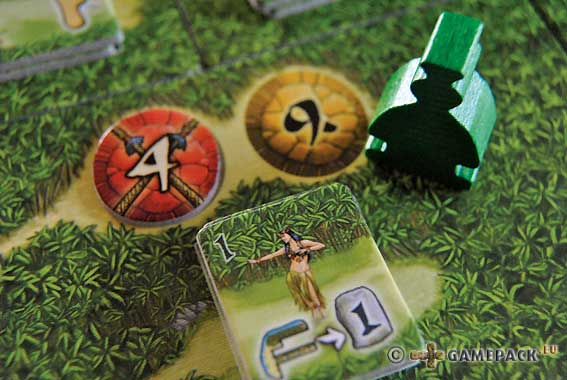 |
|
These observations make 'Hawaii' a game that may not appeal to all, since for family players it may be a bit too complex and long, while experienced players will choose a game with less luck. To each its own, but the terrific design of the game alone makes it worth at least a try. |
|
|
| x |
|
|
|
|
|
|
|
|
|
|
|
|
|
|
|
|
|
|
|
|
|
|
|
|
|
|
|
|
|
|
|
|
|
|
|
|
|
|
|
|
|
|
|
|
|
|
|
|
|
|
|
|
|
|
|
|
|
|
|
|
|
With Hawaii publisher Hans im Glück has delivered yet again a top-product, by giving the in itself abstract game such a thematic atmosphere. Also noticeable is the fact that the game is playable for 2 to 5 players, without any rule changes.
This Hawaii is truly worth visiting, and it can be expected that it will not be a one-of-a-lifetime experience, for which the real Hawaii is known!
© 2012 Edwin van de Sluis
Hawaii, Gregory Daigle, Hans im Glück, 2011 - 2 to 5 players, 10 years and up, 60-90 minutes
|
|
|
  |
|
|
|
|
|
|
|
|
|
|
|
|
|
|
|
|
|
|
|
|
|
|
|
|
|
|
|
|
|
|
|
|
|
|
|
|
|
|
|
|
|
|
|
|
|
|
|
|
|
|
|
|
  |
|
|
|
|
|
|
|
|
|
|
|
|
|
|
|
|
|
|
|
|
|
|
|
|
|
|
|
|
|
|
|
|
|
|
|
|
|
|
|
|
|
|
|
|
|
|
|
|
|
|
|
|
  |
Yet again a HiG game of the same class: a bit of tactics and lòts of gaming pleasure with a pleasant atmosphere |
  |
  |
|
|
|
|
|
|
|
|
|
|
|
|
|
|
|
|
|
|
|
|
|
|
|
|
|
|
|
|
|
|
|
|
|
|
|
|
|
|
|
|
|
|
|
|
|
|
|
|
|
|
|
|
  |
|
|
|
|
|
|
|
|
|
|
|
|
|
|
|
|
|
|
|
|
|
|
|
|
|
|
|
|
|
|
|
|
|
|
|
|
|
|
|
|
|
|
|
|
|
|
|
|
|
|
|
|
  |
|
|
|
|
|
|
|
|
|
|
|
|
|
|
|
|
|
|
|
|
|
|
|
|
|
|
|
|
|
|
|
|
|
|
|
|
|
|
|
|
|
|
|
|
|
|
|
|
|
|
|
|
  |
|
|
|
|
|
|
|
|
|
|
|
|
|
|
|
|
|
|
|
|
|
|
|
|
|
|
|
|
|
|
|
|
|
|
|
|
|
|
|
|
|
|
|
|
|
|
|
|
|
|
|
|
  |
|
|
|
|
|
|
|
|
|
|
|
|
|
|
|
|
|
|
|
|
|
|
|
|
|
|
|
|
|
|
|
|
|
|
|
|
|
|
|
|
|
|
|
|
|
|
|
|
|
|
|
|
  |
|
|
|
|
|
|
|
|
|
|
|
|
|
|
|
|
|
|
|
|
|
|
|
|
|
|
|
|
|
|
|
|
|
|
|
|
|
|
|
|
|
|
|
|
|
|
|
|
|
|
|
|
| x |
|
|
|
|
|
|
|
|
|
|
|
|
|
|
|
|
|
|
|
|
|
|
|
|
|
|
|
|
|
|
|
|
|
|
|
|
|
|
|
|
|
|
|
|
|
|
|
|
|
|
|
|
|
|
|
|
|
|
|
|
|
| x |
|
|
|
|
|
|
|
|
|
|
|
|
|
|
|
|
|
|
|
|
|
|
|
|
|
|
|
|
|
|
|
|
|
|
|
|
|
|
|
|
|
|
|
|
|
|
|
|
|
|
|
|
|
|
|
|
|
|
|
|
|
 |
|
|
|
|
|
|
|
|
|
|
|
|
|
|
|
|
|
|
|
|
|
|
|
|
|
|
|
|
|
|
|
|
|
|
|
|
|
|
|
|
|
|
|
|
|
|
|
|
|
|
|
|
 |
|
|
|
|
|
|
|
|
|
|
|
|
|
|
|
|
|
|
|
|
|
|
|
|
|
|
|
|
|
|
|
|
|
|
|
|
|
|
|
|
|
|
|
|
|
|
|
|
|
|
|
|
| x |
|
|
|
|
|
|
|
|
|
|
|
|
|
|
|
|
|
|
|
|
|
|
|
|
|
|
|
|
|
|
|
|
|
|
|
|
|
|
|
|
|
|
|
|
|
|
|
|
|
|
|
|
|
|
|
|
|
|
|
|
|
 |
|
|
|
|
|
|
|
|
|
|
|
|
|
|
|
|
|
|
|
|
|
|
|
|
|
|
|
|
|
|
|
|
|
|
|
|
|
|
|
|
|
|
 |
|
|
|
|
|
|
|
|
|
|
|
|
|
|
|
|
|
|
|
|
|
|
|
|
|
|
|
|
|
|
|
|
|
|
|
|
|
|
|
|
|
|
|
|